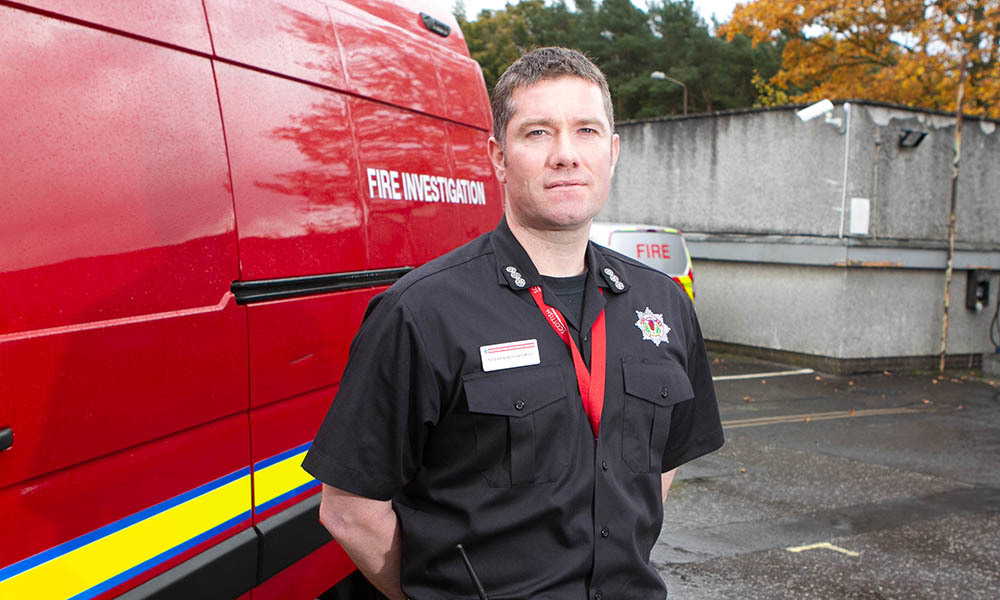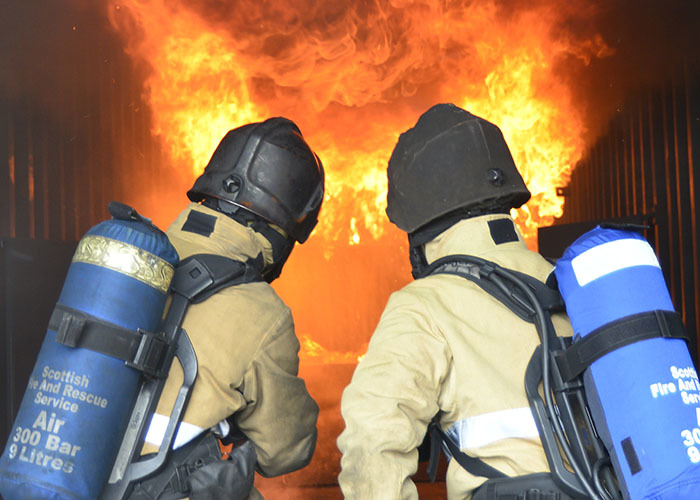
Fire can devastate lives on so many levels – from the damage and destruction to properties, to the sometimes incalculable human costs.
Few understand this better than the specialist fire investigation teams who attend in the aftermath of serious incidents, seeking answers amid scenes the rest of us hope we never have to witness.
Station Manager Steven Bosworth is one of the officers overseeing this work for the Scottish Fire and Rescue Service.
Now 42, he joined the service in 1998, after working for a year in retail management following university, his desire to make a difference compelling him to apply for a job.
He recalled: “My dad had friends in the fire service and it was always something I was interested in. At school when they did the careers questionnaire the fire service came up and it stayed there in the back of my mind. Then, while I was working in London, my dad saw a newspaper advert, cut it out and sent it to me. That was my cue to apply.”
After going through training, Steven was initially based in East Lothian, and remembers clearly the first call-out that made him stop in his tracks.
“It was a road traffic collision locally to East Lothian where I am from. A female driver was trapped in her vehicle and though, fortunately, she survived, the image of her covered in blood stuck with me.
“I’d never seen anyone badly injured before I joined the service.”
Sadly, however, incidents involving casualties are something Steven and his colleagues have learned to adapt to.
He said: “My first serious house fire was in a flat in Edinburgh around 15 years ago. I remember starting to do a perimeter check, and being told there was an adult male and female inside.
“The male was pulled out by the crew and unfortunately he had died. The female was pulled out badly burned but showing signs of life. I remember how surreal it all felt, but it was about keeping your mind on the job, evacuating the other flats and ensuring the situation was safe.
“Every time you see someone injured or worse, you think about how it affects their families and friends but we have to get on with what we’re trained to do.”

In 2016-17 there were 44 deaths from fires in Scotland, 31 of those a result of accidental fires at home.
In his role overseeing investigation teams across Scotland, Steven has become acutely aware of the major causes of fire – and how preventable they ultimately are.
“In the last five years, 61 per cent of the fire fatalities we’ve had involved people aged 60 or over. Every one of those had a contributing factor. It might involve mobility, they may live alone, they’re smokers, alcohol dependent; there’s no one person who doesn’t have a contributing factor,” said Steven.
“With every incident where someone has lost their home or even their life, you do get the sense of waste when you think it could have been prevented.
“We work with partner agencies and our crews deliver free home fire safety visits where we try to identify vulnerability, mobility problems, chaotic lifestyle, and we can refer to social services or local authorities to work together to see what we can do to make home situations safer.
“Whenever a fire fatality occurs we do all the background checks to see what had been done around prevention before, and we ask what more could have been done.”
Where the cause of a fire is immediately obvious, investigators may not need to be called in. But, explained Steven, in situations where a fire is unusual or complex, someone has died, a crime is suspected or the blaze has resulted in high-value damage, an investigation will be required.
Whatever the scenario, there is often a common thread that links accidental fires in the home.
“For every fire we investigate, it’s declared usually after a case conference whether it was preventable or not – and a clear majority are. I’ve seen cases where people have used an electric heater to dry clothing, they maybe haven’t read the instructions or know to keep it clear of anything which can catch fire and it has been the cause of serious fires and even fatalities.
“Perhaps smoke detectors have been fitted but after all that someone has still died because they have mobility issues and were smoking in bed, it has caught fire and they’ve not been able to get out quickly enough.
“It’s such a sense of tragedy and that’s why we’re putting a lot of resources into prevention.
“Having a neighbour or family member checking as often as they can really makes a difference. Carelessness shouldn’t have to end in tragedy and we can all play a part in preventing that.”
THE ELDERLY AT RISK
Older people are significantly more at risk from fire and need to take steps to protect themselves.
- One of the ways you can best do this is to fit a working smoke alarm in the hallway on each level of your home, plus an alarm in your living room that will provide early warning in case of fire.
- Additional alarms in bedrooms – particularly for those with poor mobility or who are bedridden – provide even greater protection.
- Once alarms are fitted, they should be tested every week and maintained.
- More fires start in the kitchen than any other room in the house, with deep frying using fat or oil, presenting a major risk. Using a thermostat-controlled electric deep-fat fryer is a much safer option.
- Leaving a pan unattended on a cooker is another significant cause of fire, and cooking when tired or if you’ve been drinking alcohol means you are more likely to fall asleep and less likely to wake up if a fire does start.
- Smoking, particularly when drinking, is another major cause, with overloaded plug sockets, lit candles and poorly maintained electric blankets also among the hazards associated with house fires.
If you are concerned about fire safety within your own home or that of an elderly loved one or neighbour, you can arrange for the Scottish Fire and Rescue Service to carry out a free Home Fire Safety Visit, following which they can also fit smoke alarms free of charge if required.
To arrange you can:
- Call 0800 0731 999
- Text ‘FIRE’ to 80800 from your mobile phone
- Click here to find the number of your local fire station, or complete an online form.
DID YOU KNOW?
Greater prevention focus has seen fires decline by more than 40% over the last decade BUT…
Over the last 5 years:
- 61% of house fire fatalities were aged 60 and over
- 34% of casualties were over 60
- 93 people over 60 have died in house fires.

Enjoy the convenience of having The Sunday Post delivered as a digital ePaper straight to your smartphone, tablet or computer.
Subscribe for only £5.49 a month and enjoy all the benefits of the printed paper as a digital replica.
Subscribe